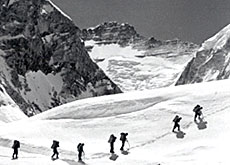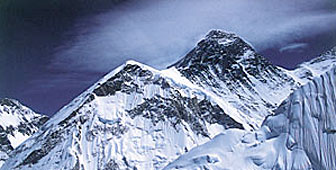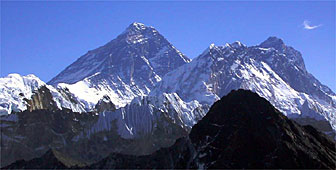Popular Everest suffers from overcrowding

Climbers from around the world have been flocking to Mount Everest to climb the mountain on the 50th anniversary of the first ascent.
Two Swiss mountaineers who have stood on top of the world – Hansruedi von Gunten and Thomas Zwahlen – talked to swissinfo about how climbing Everest has changed.
Von Gunten and Zwahlen represent two very different generations of climbers. The former reached the summit with Dölf Reist on May 24, 1956, while the latter completed his ascent on May 26 this year.
Despite the generation gap the two men have much the same outlook on climbing.
“The pictures we saw this year of people waiting their turn to stand at the summit were terrible,” said von Gunten. The former chemistry professor adds that he is pleased that he was among the first to get there 47 years ago.
Zwahlen, a 35-year-old guide from Thun in canton Bern, admits that the number of people climbing the mountain was a concern.
“The biggest worry for me while I was preparing my expedition was the queue at the Hilary Step,” he told swissinfo.
No race
Zwahlen was among the 140 lucky ones who stood on top of Mount Everest this year. Hundreds of others had to turn back, beaten off the mountain by bad weather and frostbite.
The young guide says that his expedition was lucky. The path to the summit wasn’t overrun by the time he got there with three other climbers.
Zwahlen dismisses the idea of a competition among climbers to scale Everest.
“It wasn’t a race with one another to get to the top,” he said. “When we were waiting for the weather to clear, we all worked together, and that was something I really appreciated.”
But he admits that there were many people there that shouldn’t have been. Some critics have gone as far as saying that with ropes leading all the way to the summit, anyone with enough money can climb Everest.
Zwahlen says the ropes are just a sign of how much of a business climbing Everest has become. “Mountain climbing and trekking constitute the only revenue for the region’s Sherpas,” he told swissinfo.
Climbing ban?
Sir Edmund Hilary, the first man to reach the top of Mount Everest, said during the 50th anniversary celebrations in Nepal that climbers should perhaps be banned from the mountain for a few years, to give it some time to recover.
Von Gunten believes that this idea would be hard to implement. “You can’t stop people from climbing Everest,” he said.
He points out the failed attempt to close off the awesome Eiger north face after a series of accidents as one example of why such a plan won’t work.
The pioneering climber reckons the mountains are there for everyone, not just for some specialists to enjoy.
Von Gunten fears that such a closure would also have unwanted side effects. “The return of so many people waiting to climb Everest could be more than the region around the mountain could stand,” he told swissinfo.
Zwahlen would like to see fewer climbers tackling the mountain, but not by banning them or restricting oxygen use.
He reckons that guides or expeditions should test their clients’ climbing technique and experience before tackling the world’s highest mountain. He even suggests that they should have already climbed an 8,000-metre summit as a prerequisite.
Solitude
Climbing equipment has seriously improved in the 50 years since Everest’s summit was reached for the very first time. But Zwahlen says that better climbing gear does not compensate for a lack of experience or talent.
Looking back at his own experience, Von Gunten admits that he wouldn’t even use the tent he had for his Himalayan ascent for a camping trip now.
Zwahlen says he wouldn’t have liked to spend a night in that tent either on the South Col as his predecessor had. But he does envy von Gunten’s solitude up on the mountain.
“Today, a climber is just part of a long chain reaching all the way to the summit, and is no longer alone as he was in the past,” he said.
swissinfo, Renat Künzi (translation: Scott Capper)
May 29, 1953: Edmund Hilary and Sherpa Tenzing Norgay were the first people to reach the summit of Mount Everest.
Hanruedi von Gunten was part of the third team to stand on top of the world in May 1956. He never returned to the Himalayas.
Since 1953, over 1,200 people have stood on top of Everest.
Thirty years after Hilary and Tenzing’s first ascent, only 143 people had completed the climb successfully.
Numbers began to increase after commercial expeditions were launched in the 1980s.

In compliance with the JTI standards
More: SWI swissinfo.ch certified by the Journalism Trust Initiative



You can find an overview of ongoing debates with our journalists here . Please join us!
If you want to start a conversation about a topic raised in this article or want to report factual errors, email us at english@swissinfo.ch.